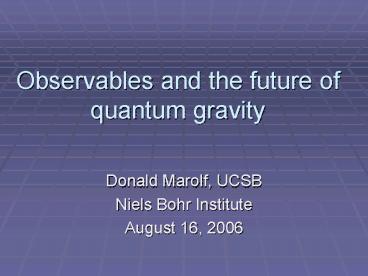Observables and the future of quantum gravity PowerPoint PPT Presentation
1 / 24
Title: Observables and the future of quantum gravity
1
Observables and the future of quantum gravity
- Donald Marolf, UCSB
- Niels Bohr Institute
- August 16, 2006
2
Classical General Relativity
- Diffeomorphism Invariance ? Relativity
xa ? xa xa(x)
Only relations between physical events are
observable.
3
The problem of time
- In cosmology,
and H, A 0.
Relativity Advancing the time coordinate does
not change the invariant relations between events.
S
Classical GR Use relational observables
4
Quantum Theory?
- How to construct relational quantum observables
in the effective theory? - What are their properties?
- How do they reproduce local physics?
Progress to date
- Relational QFT observables exist!
- Pesudo-local
- However, IR effects are important!
Future
- Large cosmologies and eternal inflation.
5
Outline
- Systems with boundaries (Asymptotically Flat
space, AdS) - 01 models
- d1 cosmologies and IR effects
6
1. Systems with boundaries
- Commonly discussed observable The S-matrix
Reminder Diffeos which act on the Bndy are not
gauge.
E.g. (asymptotic) Poincare transformations are
symmetries w/non-zero generators
7
More generally, any quantity evaluated on the
Bndy is an observable.
AdS
Asympt. Flat
Expect additional observables at i0 analytic
continuation of S-matrix
y
z
Z
x
i0
i0
x
y
ltf(x) f(y) f(z)gt
Ashtekar-Romano representation of i0.
8
More local observables?
(A challenge for AdS/CFT)
We do not measure bndy observables in the
lab. Our labs do not stretch to the boundary!
- No truly local observables
But, perhaps pseudo-local? I.e., approximate
local observables in appropriate circumstances.
9
Looks easy if make use of Boundary!
or, fix coordinates on boundary and fix gauge
ExampleAdS
fa (o - m2)xa
x
Z g exp(iS)
g exp(iS) d(f) DFP
Observables are relative to boundary.
10
Q1 Are pseudo-local obs. independent of boundary
obs.?
- Classically Yes, black holes can have internal
dynamics not seen at the boundary. - Quantum? AdS/CFT suggests no.Boundary theory
is dual to bulk.
CFT microstates account for black hole entropy
expect these to capture all details of black hole
microstates.
11
Q2 How are pseudo-local obs. related to boundary
obs?
- What is the dictionary?
- How to get info out of black holes?
- How does the bulk arise as an effective
description of the CFT?
Exciting progress, but radial direction remains a
chalenge.(See talk by D.B.)
12
2. Cosmology
- What if no boundary to space?
Classical relational observables
Take d scalar fields, Za Z1,Z2,Zd in config.
where Zaxa selects unique event.
fZaxa
or, more generally,
fZaxa
See also DeWitt, or Ambjorn others in DT
literature.
Quantum Theory?
13
01 models reparametrization-invariant QM
- E.g., mini-superspace models.
- Canonical example is free particle
Define
Can show
1) is a well-defined observable. 2)
Closely related to Newton-Wigner operators. 3)
Unitary Evolution
References CQG 12 (1995) 1199 gr-qc/9404053.
CQG 12 (1995) 2469
gr-qc/9412016.
14
Well-defined observable
Note
1) Just QM (no QFT), so integrand is
well-defined. 2) Integral converges sinceas
.
15
Well-defined observable
Observable Commutes with H p2 m2 !
For A A(p,q), we have
Integrand w is proportional to N.
Integrand of commutator is total derivative
QED
16
In general
Consider any 01 (QM) system w/ diffeo inv. and
an asymptotic clock dof. I.e.
as .
1) Bounded functions A on the phase space define
observables (A)ct. 2) In the approximation that
c ? c const is a symmetry (ideal clock),
evolution is unitary
17
3. Restore Space
(Giddings, DM, Hartle hep-th/0512200)
Simple model d free scalar fields, Za
Z1,Z2,Zd.
Restrictions
Set GN 0 Flat Minkowski space. Take Zs free.
No self-interactions, no interactions with other
scalar field (f, with A A(f)). Linear
background Za lxa dZa, quantize dZa.
Operators renormalized by covariant
point-splitting. (Preserves tensor character
under diffeos.)
18
Results d gt 21
- These operators are well-defined andapproximate
local observables
where xaixai/l, and when
Smearing scale
and
In particular, cannot take s to zero
Together,
Background energy density sets bound on
resolution!
19
Turn gravity back on.
- Propagating gravitons not a problem(perturbative
effective field theory) - But, also Coulomb field from energy density r.?
Can only instrument finite region of size R.
R
If no black hole or grav collapse resolution ?
Thinning of degrees of freedom, but thinner than
holography. Expect that our observables are not
complete set! Are others less local?
20
IR Effects
R
Z-vacuum outside
- Operators integrate over vacuum region.
- Vacuum not an eigenstate of any local operator.
Via quantum fluctuations, vacuum can
impersonate instrumented region. - Small finite probability exp(-z2/s2)
exp(-R2/d2) - but, infinite volume ? divergent fluctuations
not well-defined in infinite spacetimes.
Requires IR cut-off on space may reflect
fundamental structure of quantum gravity.
21
Large Finite Universes are OK
(Multigrid)
Gaussian sampling? exponential suppression. Vacuum
not resolved, just distinguished from R.
R
L ltlt exp(Rl/s)
d4, d 1/TeV
L
22
does not exist in infinite space
- Note differs from gauge fixed observables
attached to boundary. - Coordinates anchored to bndy have no energy
density no back reaction no problems! - Recall OK because translations are not gauge.
- But in finite volume, all diffeos are gauge.
- No continuity two distinct classes of
observables.
23
The future??
- If there are no better observables,
- For ,
- Will the universe become fuzzy as ?
- Will this help us understand L and the
landscape?
24
Summary
- Non-trivial to build Observables for quantum
gravity. - However, becomes easy with a boundary Bndy
observables, and pseudo-local observables
anchored to bndy. (e.g., AdS) - Fully relational observables can exist w/o bndy,
but IR divergences! - Fuzzy future?
- Fundamental distinction between finite and
infinite universes?

